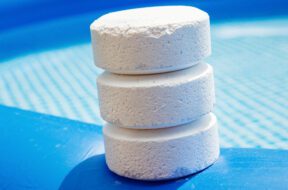
Want to learn more about algaecide? Read on to find out when to add algaecide to your pool maintenance routine and other helpful tips.
The ideal pH level in both pools and hot tubs is 7.4 to 7.6. This is the level where water is most comfortable for swimmers while also maximizing chlorine’s sanitizing ability.
The term pH is an acronym for “potential hydrogen” or “power of hydrogen”, depending on which chemist you ask. The “p” is lower case so as not to be confused with the symbol of the element phosphorus. The potential hydrogen of a substance dictates how acidic or basic (alkali) that substance is.
The potential hydrogen is measured on a logarithmic scale from 0 to 14, where 0 is the most acidic and 14 is the most basic. Because the pH scale is logarithmic, a substance with a pH of 0 is ten times more acidic than a substance with a pH of 1. For reference, fresh water is assumed to be neither acidic nor basic and therefore have a pH of 7.
When it comes to pool chemistry, pH is critically important because it dramatically influences the sanitizing ability of chlorine. Learn more about The Relationship Between Pool Chlorine and pH.
This question has multiple answers and depends on the scenario of your pool chemistry. Let’s begin with the most common scenario before we address two exceptional cases.
Under normal conditions when you are using your pool, the recommended pH is 7.4 to 7.6. If pH drops too low, the acidity of the water may irritate your skin and even cause a rash. If the pH is too high, chlorine’s ability to sanitize your water will be diluted and you may contact or ingest unwanted bacteria such as raw fecal matter.
There are two other scenarios that may warrant lowering your pH with muriatic acid to increase the sanitizing ability of free chlorine. The first and more common scenario is when you shock your pool. You may find it helpful to lower pH to a range between 7.0 and 7.4 to increase the sanitizing power of your pool shock. The second scenario is when your total alkalinity is too high (i.e. greater than 120 ppm) and you wish to reduce it. In this case, you will want to lower pH to a range between 7.0 and 7.2 ppm and then aerate the water to break up alkali material.
The recommended pH levels for hot tubs are virtually identical for those of pools for each of the scenarios we addressed in the previous section. Some hot tub users may find it is more comfortable to keep a pH slightly elevated – closer to 7.6 on the recommended 7.4 to 7.6 range because the hot water can be more likely to cause irritation if it is too acidic.
If you prefer more basic water in your hot tub, it is that much more important to frequently test free chlorine levels. Hot tubs have higher concentrations of users and therefore higher concentrations of contaminants. Chlorine loses its sanitizing power as pH rises, so be sure to keep plenty of free chlorine in your hot tub.

Want to learn more about algaecide? Read on to find out when to add algaecide to your pool maintenance routine and other helpful tips.

In this quick guide, we’ll answer the question “can you over shock a pool” and unveil the factors to consider when shocking a pool.

Maintaining both pH and total alkalinity in your swimming pool is important for keeping your pool properly sanitized and non-corrosive. Total alkalinity is to pH what cyanuric acid is to free chlorine. Total alkalinity stabilizes pH levels. The ideal pool pH level is 7.4 to 7.6. The ideal total alkalinity level is 80 to 120 ppm.

The Association of Pool and Spa Professionals recommends free chlorine levels for both swimming pools and hot tubs be kept between 2.0 and 4.0 ppm. However, the Center for Disease Control recommends free chlorine stay above 1 ppm in pools and 3 ppm in hot tubs.